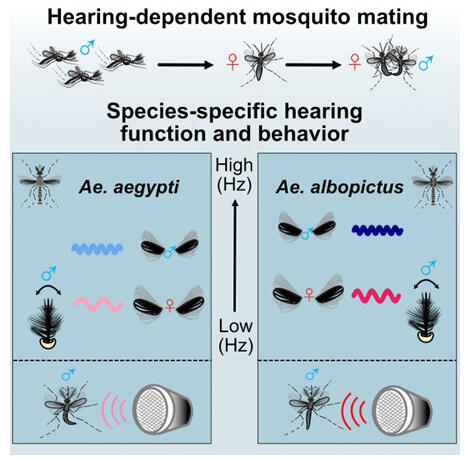A research group led by Professor Azusa Kamikouchi and Designated Assistant Professor Matthew Su of the Graduate School of Science at Nagoya University, has announced their research results showing that the male auditory characteristics and response behavior to female flight sounds are differentiated between the two closely related mosquito species Aedes aegypti and Aedes albopictus. This was found by examining the male auditory characteristics, and response behavior to female flight sounds in the two species. It is thought to be a mechanism to avoid crossbreeding. The findings are expected to contribute to the development of tools for mosquito control, such as mosquito traps to capture specific types only and were published in the June 14 issue of the international journal iScience.

Provided by Nagoya University
Mosquitoes kill about 700,000 people a year by transmitting a range of infectious diseases. They inhabit all continents except Antarctica and are vectors of diseases common in the tropics, such as dengue fever, malaria, West Nile fever, and Zika fever. Insecticides have been used to control mosquitoes, but drug-resistant mosquitoes have been identified in many parts of the world. Developing more effective control methods is a common issue worldwide.
The two species of striped mosquitoes are involved in the transmission of infectious diseases. One is A. aegypti, which is native to the African continent, and the other is A. albopictus, which is native to Southeast Asia and is also found in Japan. The two species are closely related to each other. Although the two species originally inhabited different areas, some areas in which both species were found have been reported due to global warming and human activities. Meanwhile, the presence of the two mosquito species in the same area can cause regional differences in subsequent changes in distribution, and it was unclear how they interacted to form each population.
Previously, the research group has been conducting biological studies to explore for weak points for the purpose of controlling mosquitoes. This study aimed to understand the mating behavior of A. aegypti and A. albopictus. Since it has been reported that male mosquitoes hear female flight sounds to recognize females that have come closer and joined the swarm, they examined the possibility that males identify females through a mechanism responsible for acoustic communication.
Mosquitoes receive sounds as vibrations with the hairs at the tip of their antennae (sound receivers or flagella), which transmit the signals to the brain through the actual auditory organ (Johnston's organ) at the base of the antennae. First, they investigated whether the flight sounds differ between A. aegypti and A. albopictus. Male and female mosquitoes of the two species were placed in separate cages, and their flight sounds recorded with a microphone were analyzed to determine the frequency components of their wing beats.
The wing beat frequencies of male and female mosquitoes of the two species were found to be different as follows: 532 Hz (female) and 887 Hz (male) for A. aegypti and 566 Hz (female) and 921 Hz (male) for A. albopictus. Furthermore, when male mosquitoes of each species were exposed to artificial sounds of various frequencies (350-850 Hz) played through a speaker, they responded most strongly to the sound, with the frequency matching that of the wingbeats of female mosquitoes of the same species. When the male mosquitoes heard the conspecific female flight sounds, they did not fly around but landed on the netting closest to the speaker.
Next, they compared the characteristics of the auditory system and neural responses of sound-exposed mosquitoes between the two species. They used a laser Doppler vibrometer to measure the vibrations of the sound receivers when male mosquitoes were immobilized and exposed to sounds of various frequencies. The highest vibrational responses of the auditory organ were observed when the male mosquitoes were exposed to the conspecific female wing beat frequencies. This result indicates that the optimal frequency of the auditory organ also differs between the two species. Meanwhile, the responsiveness of the auditory sensory neurons to different frequencies did not differ between the species, and the highest responses were observed at frequencies considerably lower than the female wing beat frequencies of the same species.
In this experiment, a measurement electrode placed at the base of the antenna was used to measure the response of auditory sensory neurons when the antenna was vibrated at various frequencies. Previous studies on acoustic communication in mosquitoes have reported that males may detect an auditory component (distortion product) produced inside the auditory organ when they hear their own and female flight sounds. Therefore, the group calculated the theoretical values of distortion products generated from the male and female flight sounds for each species and found that the values were in agreement with the frequencies to which the auditory sensory neurons responded most strongly. This result supports the idea that each species possibly hears the distortion product produced by male and female wingbeats.
The research group have previously conducted experiments to capture male mosquitoes in the field by exposing them to sounds, but the problem has been that mosquitoes cannot be captured in the field as successfully as in laboratory experiments. They presume that this may be because the optimal sound frequencies were not used.
Kamikouchi said, "Targeting the mosquito auditory system is a promising option for controlling mosquito populations. The findings of our present study may underpin a proposal that species-specific "auditory" characteristics can be utilized to selectively control the propagation of A. albopictus and A. aegypti. Moving forward, we are going to test this idea with an aim to develop an effective mosquito control methodology in the field."
Journal Information
Publication: iScience
Title: Differences in male Aedes aegypti and Aedes albopictus hearing systems facilitate recognition of conspecific female flight tones
DOI: 10.1016/j.isci.2024.110264
This article has been translated by JST with permission from The Science News Ltd. (https://sci-news.co.jp/). Unauthorized reproduction of the article and photographs is prohibited.




